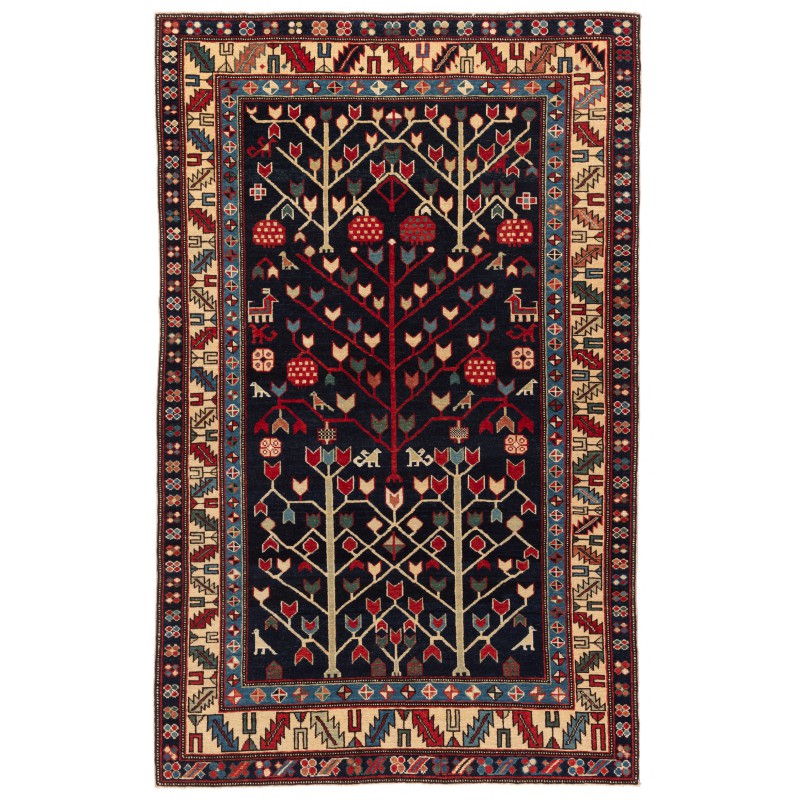
- Stock: 売り切れ
- Model: C31010
- サイズ: 109cm x 182cm
この絨毯の情報は、Ian Bennettによる著書『Oriental Rugs Volume 1 Caucasian』(Oriental Textile Press、Aberdeen、1993年、pg.76)からのものです。これはカザク地域、コーカサス地域の19世紀後半の庭園デザインの木の絨毯です。この木と低木のデザインは、16世紀と17世紀のサファヴィ朝の庭園絨毯から派生しています。18世紀と19世紀に編まれたより角ばったスタイルのクルド系バージョンの木と花の低木の方向性デザインもあります。コーカサス地域とこのタイプのペルシャ織物との直接の関連性は、現在はイェルサレム博物館のマイヤー財団所蔵のユニークな18世紀初頭の青地のコーカサスの木の絨毯(Lefevre, Caucasian Carpets, no. 4)によって提供されています。このグループの木は常にほぼ同じ方法で描かれ、ベースには二重頭の鳥のモチーフがあります。この特定の鳥と木の組み合わせの描写のほぼ正確な相当物は非常に稀なバルーチ絨毯(例:Victoria and Albert Museum no. T. 195-1922、Jenny Housego, Tribal Rugs, plate 25で掲載)にも見られます。また、木のデザイン自体はいくつかのバルカンのキリム(Ulrich Schürmann, Teppiche aus dem Orient, no. 97)や、ビッド・マジュヌンデザインの北西ペルシャの絨毯、南西ペルシャの特定のルーリ織物(例:Formenton, Oriental Rugs and Carpets, p. 176)にも見られます。この絨毯は「葉と花弁」を主とする一連のボーダーで囲まれています。この絨毯のデザインは、私たちのデザイナーによって解釈され、オリジナルに合った最適な色彩が使用されています。
The source of the rug comes from the book Oriental Rugs Volume 1 Caucasian, Ian Bennett, Oriental Textile Press, Aberdeen 1993, pg.76. This is a garden with a tree design rug from the late 19th century, Kazak region, Caucasus area. This tree-shrub design is derived from 16th and 17th-century Safavid garden carpets; those with directional designs of trees and flowering shrubs from the more angular and stylized Kurdish versions woven in the 18th and 19th centuries. A direct link between Caucasian and Persian weavings of this type is afforded by the unique early 18th-century blue-ground Caucasian tree carpet now in the Mayer Foundation, Jerusalem Museum (Lefevre, Caucasian Carpets, no. 4). The tree of the present group is always drawn in much the same manner and has the double-headed bird motif at the base; an almost exact equivalent of this particular rendering of the bird-tree combination is found on a very rare type of Baluch rug (i.e. Victoria and Albert Museum no. T. 195-1922, illus. Jenny Housego, Tribal Rugs, plate 25), while the tree design itself is also found on some Balkan kilims (Ulrich Schürmann, Teppiche aus dem Orient, no. 97), on north-west Persian carpets of the Bid Majnun design and on certain Luri weavings from south-west Persia (i.e. Formenton, Oriental Rugs and Carpets, p. 176). It is framed with a series of borders, the main of which is the “leaf and calyx”. The design of the rug is interpreted by our designers, and the most appropriate colors to match the original is used for this rug.
